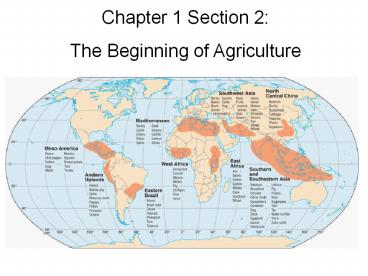Chapter 1 Section 2: The Beginning of Agriculture - PowerPoint PPT Presentation
1 / 23
Title:
Chapter 1 Section 2: The Beginning of Agriculture
Description:
Chapter 1 Section 2: The Beginning of Agriculture Main Idea The development of agriculture was a major turning point in human history and significantly changed the ... – PowerPoint PPT presentation
Number of Views:195
Avg rating:3.0/5.0
Title: Chapter 1 Section 2: The Beginning of Agriculture
1
Chapter 1 Section 2 The Beginning of
Agriculture
2
Main Idea The development of agriculture was a
major turning point in human history and
significantly changed the way in which many
people lived.
- Reading Focus
- What new tools and technologies did early humans
develop during the New Stone Age? - How did early agriculture develop and spread?
- In what ways did the development of agriculture
change Stone Age society?
3
I. The New Stone Age
- The Neolithic Era - about 8000 BC to 3000 BC
4
I. The New Stone Age
- Advances in tool making defined the Neolithic Era
5
I. The New Stone Age
Old - Stones chipped to make points New -
Polished stones to make points Specialized tools
- chisels, drills, and saws
Flint Knapping
6
II. Development of Agriculture
- Last Ice Age ended about 10,000 years ago new
animals and plants like grains, appeared
7
II. Development of Agriculture
- c.10,000 years ago - people learned to farm,
became food producers - the Neolithic Revolution
8
II. Development of Agriculture
- People gathered wild grains, learned connection
between seeds and plants
9
II. Development of Agriculture
- Domestication selective growing/breeding of
plants/animals best traits were perpetuated
10
II. Development of Agriculture
- First domesticated animals probably dogs
followed by cattle, sheep, etc.
11
II. Development of Agriculture
- Domesticated plants and animals reliable food
source large animals were put to work
12
III. Agriculture Changes Society
- Reliable food supply resulted in world population
increase
13
III. Agriculture Changes Society
- Some people became nomadic pastoralists others
formed farming settlements
Nomadic Mongols Camp
14
A. Early Farming Societies
- Settlements grew into villages and towns
5,000 year-old Neolithic village of Skara Brae,
occupied from about 3180 BC to 2500 BC
15
A. Early Farming Societies
- Improved agriculture needed fewer workers
artisans/craftsmen appeared trade increased
Funerary pottery
Beads and Pendants
16
A. Early Farming Societies
- Social status based on wealth, influence, and
authority men gained dominance over women
17
A. Early Farming Societies
- Other changes formalized religion warfare over
land/resources crop failure meant famine
increased disease
Stonehenge
Maikop Gold Bull Russia, 2500 BC
18
B. New Technologies
- Cattle pulled plows
19
B. New Technologies
- New tools to prepare grains clay pottery wool
spun into yarn c. 3000 BC - the Bronze Age
20
C. Catal Huyuk
- c. 6000 BC - largest Neolithic village covered
30 acres, 5000 to 6000 people
21
C. Catal Huyuk
- Farmed, raised animals conducted wide-ranging
trade
22
D. Otzi the Iceman
- 1991 hikers found a frozen 5300 year-old
Neolithic man in Italys Alps
23
D. Otzi the Iceman
- Otzi added great deal of information about
Neolithic life
Otzi the Iceman (also spelled Oetzi and known
also as Frozen Fritz)































